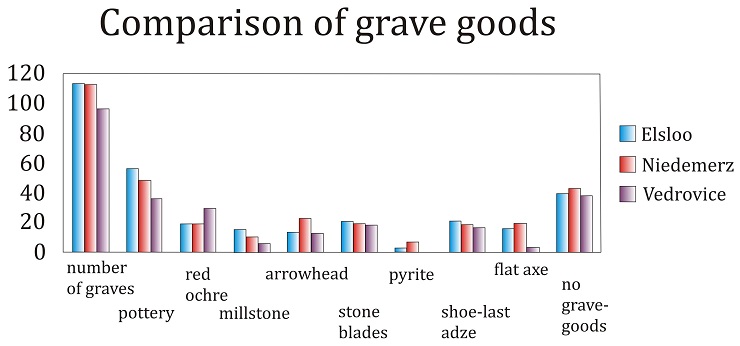Should a student in the environment of our universities be asked during the exam about the Neolithic burial rite, if his or her answer is considered to be correct s/he usually begins with the Vedrovice necropolis. This Moravian site indeed belongs to the canon of Central European archaeological research and the results of its research have, rightly, been a centre of attention for two decades. The unearthing of the burial ground during the years between 1975-1982 brought up the discovery of 96 graves dating back to the early development phase of the Linear Pottery culture, thereby to the very beginnings of our own Neolithic. The complete processing of the findings obtained enables us to ask questions not only about the outer form and the chronology of the artefacts that are represented in the graves, but also about the inner structure of the actual society, which, we believe, can be studied on the basis of these artefacts and of the actual burials.
|
|
| A comparison of the number of graves and of their equipment in regard to the three burial grounds of the Linear Pottery culture: Vedrovice (CR), Elsloo (Netherlands) and Niedermerz (Germany). Regardless of the geographic distance between all the three necropolises a similar number of graves and additions were reported. According to Květina 2004, 385. |
The interdisciplinary study of natural sciences has brought about some notable results. Making use of biochemical and genetic analysis of the skeletal remains a considerable mobility of buried people was identified. Some of them had grown up in Vedrovice and after a long stay “abroad” they had returned to conclude their lives in their own native village, while others, on contrary, moved to the village during their lives. As well as raw materials and artefacts the people themselves also travelled over extensive areas of Europe. They were not only born in Vedrovice, but they also lived there and then they left it, while some of them returned after many years and also brought back with them new, unknown companions from faraway lands.
 |
| Grave No. 46 in Vedrovice contains the burial place of a young man, 166 cm tall, which was actually the standard height of Neolithic man. His posthumous equipment contained a small ceramic vessel, originally probably with some content and also a stone axe, several chipped stone tools (perhaps some arrowheads), a large curved pendant made from a Spondylus shell and a tiny bead of the same material. According to Podborský 2002, 48–50. |
The ancient custom of sprinkling lifeless corpses with red pigment has also been retained at the Vedrovice burial site. The funerary equipment, if it is contained in the graves, consists of ceramic containers, polished and chipped stone tools and jewellery made from marble, animals’ teeth and specifically from the shells of marine bivalves (Spondylus).
A comparison of the spatial distribution of the graves with the occurrence of various types of artefacts together with the results of the anthropological analysis of the people who are buried can lead to some surprising findings. First, it is self-evident that the graves that in accordance with their preserved equipment can be considered to be rich are grouped in the eastern part of the necropolis. With the exception of one child’s grave all of these other extraordinary graves belong to men. On the west side, on the other hand, there is an exclusively female group of graves. The male and the female graves additionally differed in terms of the types of ceramic vessels that were in their equipment. While in the male graves it is usually possible to encounter dish shapes, in the female graves globular shapes prevail. In contrast, however, the bottles show no specific ink to a single gender and they can be found across all the graves. To the question whether there is a link between social status of the individual and the characteristics of ceramic vessels we therefore get a positive answer.
Want to learn more?
- Podborský, V. 2002. Dvě pohřebiště neolitického lidu s lineární keramikou ve Vedrovicích na Moravě. Brno: Masarykova univerzita.
- Zvelebil, M., and P. Pettit. 2008. Human condition, life, and death at an Early Neolithic settlement: bioarchaeological analyses of the Vedrovice cemetery and their biosocial implications for the spread of agriculture in Central Europe. Anthropologie 46/2-3:195-218.
- Zvelebil, M., P. Pettitt, and A. Lukeš. 2009. Život, lásky a smrt neolitických zemědělců. Bioarcheologie vedrovických hrobů. Vesmír 88: 86–90.
- Zvelebil, M., and P. Pettitt. 2013. Biosocial archaeology of the Early Neolithic: synthetic analyses of human skeletal remains from the LBK cemetery of Vedrovice, Czech Republic. Journal of Anthropological Archaeology 32 (3): 313–329.
 Archeologické 3D virtuální muzeum
Archeologické 3D virtuální muzeum

.png)
